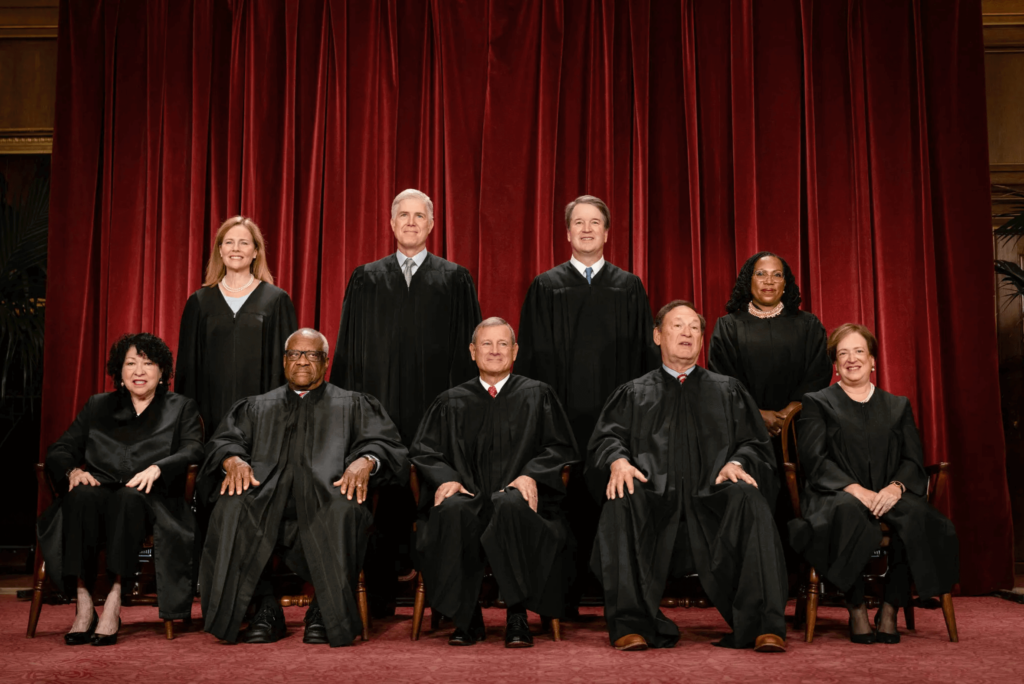Ellen Casey ‘27 | Lilly Smolenski ‘27
Affirmative Action has long been a topic of discussion among political groups, workplaces, and students alike, yet many people remain unaware of the facts and effects of this policy. Affirmative Action is defined as a policy aimed at creating more equal opportunities for people of historically underrepresented groups in society by taking factors such as race into account when accepting candidates for universities and careers. The policy in its earliest form was the result of Executive Order 10925 ruled in 1961 under John F. Kennedy, which outlawed employment discrimination based on race.

Photo Courtesy of The Supreme Court
PROS:
The main objective of Affirmative Action is to encourage increased diversity, especially in schools and workplaces. Its aim is to ensure that people who are part of underprivileged groups are being properly represented and to include different cultures and perspectives on college campuses. Trevor Cantlin ’27 comments, “Affirmative Action helps give every person an equal opportunity at higher education.”
In the workplace, considering affirmative action in the hiring process not only increases inclusion, but also grants opportunities to people who may not have historically received them. Ijaaz Abdul-Malik ’24 states, “Minority groups have not often had the same opportunities or resources in pursuing education and Affirmative Action is a way to address that.” Having an education also allows for job opportunities thus increasing social mobility. After the Students for Fair Admission vs. Harvard College ruling this summer Justice Ketanji Brown Jackson stated that, “Gulf-sized race-based gaps exist with respect to the health, wealth, and well-being of American citizens. They were created in the distant past, but have indisputably been passed down to the present day through the generations.”
Affirmative Action not only deeply affects people in minority groups, but also positively impacts students and staff of all races as well as communities. More integrated environments can create increased confidence and teamwork, all while working to remove previously-held racial biases and prejudices. One could argue that without Affirmative Action, lack of diversity could become even more detrimental to our colleges and our society than it already is. Campuses and workplaces could suffer from a limited range of perspectives and life experiences if people with a disadvantage aren’t given the same chances as their peers.
Many minorities, especially people of color, have historically been denied the same opportunities as their peers, meaning it could prove unfair to judge all candidates equally without allowing for the uneven factors that may be at play in the background. Affirmative Action targets the idea of equity, and providing opportunities to certain groups of people will create a more equitable environment where they can improve themselves and their abilities.
CONS:
While the concept of Affirmative Action has many benefits, it is a highly controversial topic due to a number of factors.
From an academic standpoint, many teachers and colleges are concerned that if students believe they will be admitted to college more easily due to outside factors, then their incentive to work hard will drastically decline.
Supporters of a blind admissions process believe that it encourages admissions staff to focus more heavily on the students’ notable achievements and extracurriculars and allow students to define themselves beyond their circumstances. “They look more into you, they look more into your academics, they look more into what you’ve done in your life, not what you look like,” comments Grace Christie ’27.
Students from non-minority groups argue that while Affirmative Action gives a more equitable opportunity for others to thrive in academic environments, they are working just as hard and feel like they are missing out on opportunities because of Affirmative Action. Discussing his decision to vote against the use of Affirmative Action in admissions settings, Supreme Court Justice Clarence Thomas stated, “Two discriminatory wrongs cannot make a right.”
Some also argue that instead of promoting a diverse environment, tensions over the policy only serve to increase division. Ashley Foppa ‘25 says, “In most colleges, minority groups still tend to be underrepresented despite the efforts of Affirmative Action.” A New York Times Analysis on the representation of minorities in elite schools states, “Black students are just 6 percent of freshmen but 15 percent of college-age Americans.” If the problem Affirmative Action was created to solve still exists, is this policy still truly necessary?
This decade-old policy continues to be a controversial topic in academic and political circles as the country debates whether or not it is the fairest way to conduct admissions processes. It is left up to all of us to decide for ourselves: Is Affirmative Action detrimental to students’ work ethic, or is it the best way to give each and every person a fair shot regardless of their background?